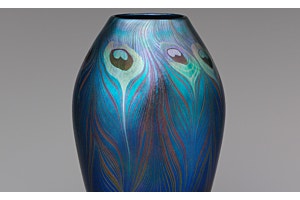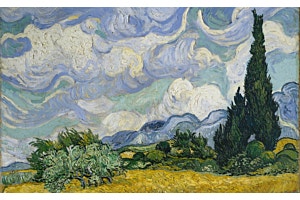
In an all-too-brief career spanning less than a decade, the illustrious illustrator Aubrey Vincent Beardsley (British, 1872–1898) produced an outpouring of inky images brimming with beauty, humor, and horror.


Beardsley's spectacular illustrations complemented the airs of the Victorian period, when art was rife with sumptuousness and nostalgia. While William Morris (British, 1834–1896) sought a return to the golden days of handicraft through thoughtful designs referencing lush, often medieval sources, Pre-Raphaelite artists such as Dante Gabriel Rossetti (British, 1828–1882) and Edward Burne-Jones (British, 1833–1898) revived enchanting maidens from history and mythology.


Enter Beardsley, who so skillfully married tradition and progress. In the Museum’s holdings is Beardsley’s first commission: an edition of Thomas Malory's 15th-century book Le Morte d'Arthur, which was reprinted in the early 1890s by the publisher J. M. Dent.


Unlike the more elitist fine presses of the time (such as William Morris’s Kelmscott Press), Dent priced his books to be accessible. Morris shunned modern developments in favor of handcrafted creations with heart, mind, and soul; Dent, however, embraced mechanical advancements in the printing process, as they allowed for the large-scale, low-cost production of titles. Instead, Dent elevated Le Morte D'Arthur with Beardsley’s elegant, high-contrast illustrations, which restored an artfulness to the publication and brought the literature to life in weird and wonderful ways. Beardsley's contribution to Le Morte d'Arthur was so well received that he was able to quit his day job as a clerk and become a career artist.


The praying angel on our etched bookmark celebrates a detail from one of the hundreds of illustrations Beardsley made to accompany Le Morte d'Arthur.


The original border design frames a tale of King Arthur’s piety in book seven, chapter one, titled, "How Beaumains Came to King Arthur's Court and Demanded Three Petitions of King Arthur." Beardsley evokes the chapter's theme with angels rendered in a medievalist aesthetic, while the lilies blooming on curvilinear stems anticipate the whiplash curves and organic motifs that defined Art Nouveau.


Beardsley's success was swift after Le Morte d'Arthur. He gleefully ruffled feathers with his taste for the grotesque and the obscene, as exemplified in his renowned illustrations for Oscar Wilde’s play Salomé (1893).


The notoriously vicious legend of deceit and revenge was the perfect undertaking for Beardsley, who so imaginatively illustrated the ancient story as retold by Wilde. He united the elegance of Art Nouveau with the fashionable flatness of Japanese woodblock prints, and thoughtfully filled negative space with splendid ornamentation. Wilde, who shared Beardsley’s razor-sharp wit, wasn’t shy in his review of the illustrations, commenting, “They are cruel and evil, and so like dear Aubrey, who has a face like a silver hatchet, with grass-green hair.”


Beardsley was conscious of his awkward appearance, and compensated for his wispy physique by cultivating the image of a dandy. Lithe and playfully lacerating, he presented like one of his illustrations come to life. But his scrawny frame was the result of recurring bouts of tuberculosis, an unrelenting affliction that would take his life at just 25 years old. In one of art history's shortest careers, Beardsley managed to capture the decadence and irreverence of fin de siècle Europe with delightfully devilish flair.


Shop the Beardsley Praying Angel Bookmark in-store and online, where you’ll find an extensive selection of decor, jewelry, apparel, and more inspired by artworks in The Met collection.



